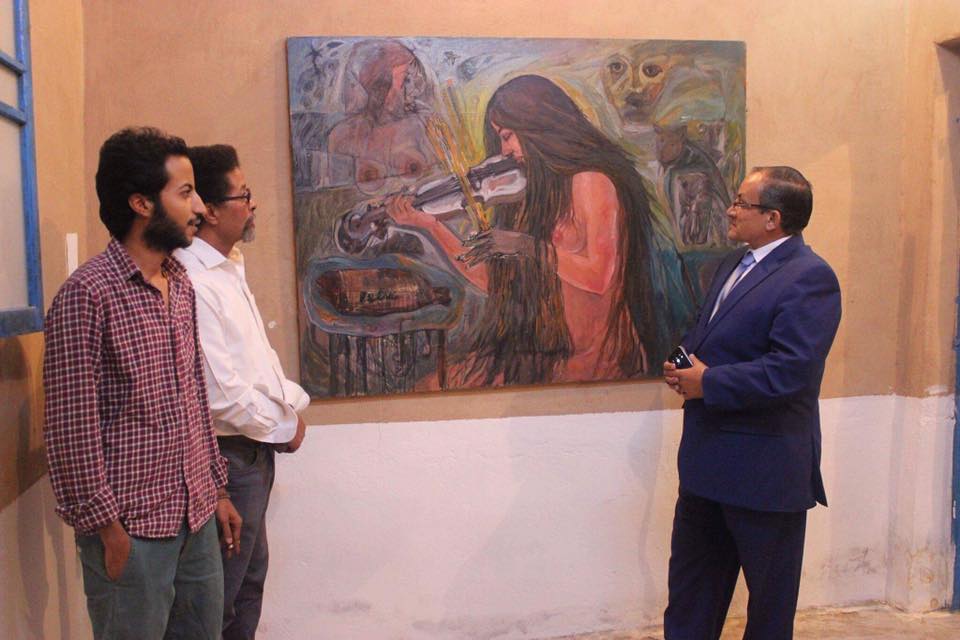For July, the phrase “summer breeze” is a grave understatement. And for this collective exhibition currently showing at the Art Corner Gallery, the word “breeze” is definitely an underestimation. Six contemporary artists reveal a vigorous storm of exquisite color and perceptive thought.
Female vigor, gender equality, and the imposition of the human face and figure are among the collection’s most potent themes. But Egyptian symbolism is perhaps the most compelling element running through this Summer Breeze.
In this seven-month-old gallery in the alleys of Zamalek, artists Fathy Ali, Hossam Sakr, Maged Bishara, Mohamed el-Moslemany, Salwa Halim and Yasser Rostom come together with their contrasting styles and backgrounds to provide us with a glimpse of Egypt’s modern art scene.
Upon entry, a breeze of female energy steals your attention. A white horse stands out against a jet black background, her face tilted gracefully to the side, displaying poignant eyes and a golden earring. A portrait of a lady grabs your eye, her features petite yet striking. Large earrings dangle down; two large golden scarabs hang elegantly below her cheeks. A profile of a woman in a burette wearing silver fish-shaped earrings also demands attention.
Egyptian women pass you by on streets, care for their infants, and hold jobs in different industries, each with a different face, a different story and a different future. Here on the walls of the Art Corner Gallery, different Egyptian women look back at you, flaunting their colors, but do not really tell you anything about their lives.
El-Moslemany is the man whose paintbrush rendered such potent portraits of women. With strong and vibrant colors, the females in el-Moslemany’s paintings appear completely transfixed in the moment. The painting is all about the girl–her beauty and her disposition. But such women appear to be detached from reality. Despite such a lack of context, one cannot escape the magnetism of such brightly painted women.
“I believe that the face tells you everything you need to know about a person,” says El-Moslemany. “Happiness and misery, for example, are feelings which are instantly revealed by your facial expressions.”
“If human beings were all identical, without variations in features and expressions, this earth would’ve been incredibly boring,” he adds.
El-Moslemany chooses to display diverse human dispositions through painting diverse female faces. The artist, he says, is truly “inspired by the incredible female energy.”
“If you journey through Egypt, from North to South and left to right, you will find that a woman’s influence always prevails,” says El-Moslemany.
Painting women in vibrant, electric colors, the artist depicts the underestimated power of women.
“Wars can start over a woman, but never over a man,” he says. But the women on el-Moslemany’s canvases do not necessarily scream out “power,” but rather imply a certain sense of flair. On his canvases, the artist also uses gold and silver paper strategically to accessorize the subject matter he prefers most.
The scarab beetle, an Egyptian emblem, appears quite strikingly in el-Moslemany’s work. In ancient Egypt, the scarab was worshiped as a symbol of regeneration, transformation and renewal. Mirroring the fertility of women, the incorporation of such a symbol enriches the artists’ depiction of the infinite female power.
By contrast, Yasser Rostom, another male artist, defies the idea of female superiority, preferring instead the notion of gender equality. In the gallery’s large glass window, two red eyes stare back at you–one belongs to a man, the other to a woman.
“Our vision is only complete and three-dimensional when we see with both eyes,” explains Rostom. “In the painting, one eye is female and the other male, because I believe that both genders need to work side by side in order for this society to flourish.”
Using black ink, Rostom combines two seemingly distant themes: the pharaonic (ancient Egyptian) culture, and the abstract. While the pharaonic era was characteristically defined and agreed upon, the ever-changing abstract field is by nature surreal and somewhat arbitrary.
Instead of using the human visage, Rostom, who was originally a sculptor, employs the whole figure to portray his ideas. And even though Rostom’s paintings may lack a palpable sense of aesthetics, his detail is impeccable.
Ancient Egyptian symbols reappear in Rostom’s pieces, coexisting with man, the human body crafted to accentuate muscles and convey utter power. “I adore the human figure, despite it being the hardest to draw,” confesses Rostom.
Also imposing abstract subject matter at the Art Corner Gallery is Hossam Sakr, an artist with international acclaim. At first glance, his paintings appear messy and incomprehensible, but with a repeated, deeper revision you are mesmerized.
His canvases, which are suffused with blues and many tints of grey, each house numerous elements, artfully collaborated. One painting brings a woman, a lizard, a man, and a large animal together, overlapping at various points, so that an eye or a leg can belong to two completely different creatures. Ultimately, though, the combination appears to constitute a single animal.
Running until 28 July, “Summer Breeze” will intrigue you. And that too, is an understatement.




